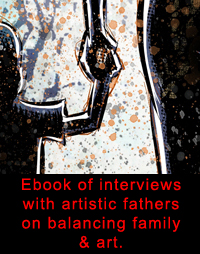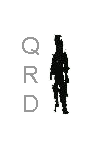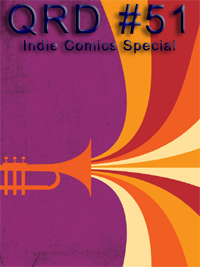
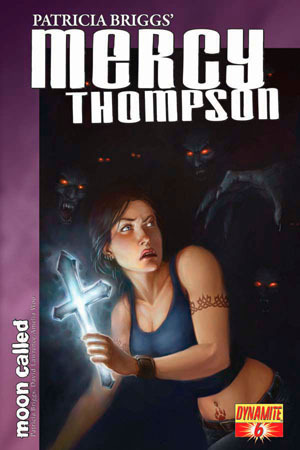
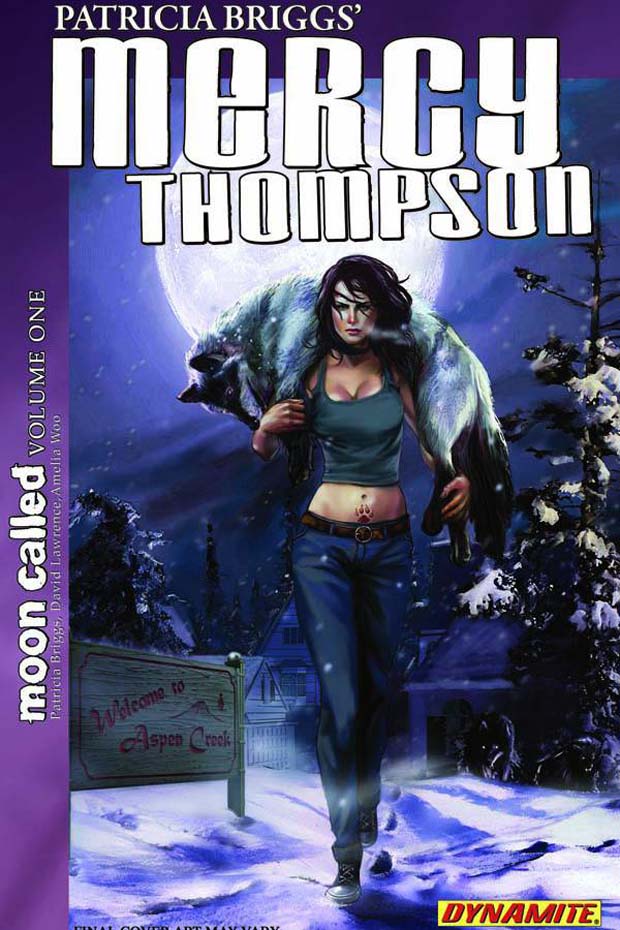
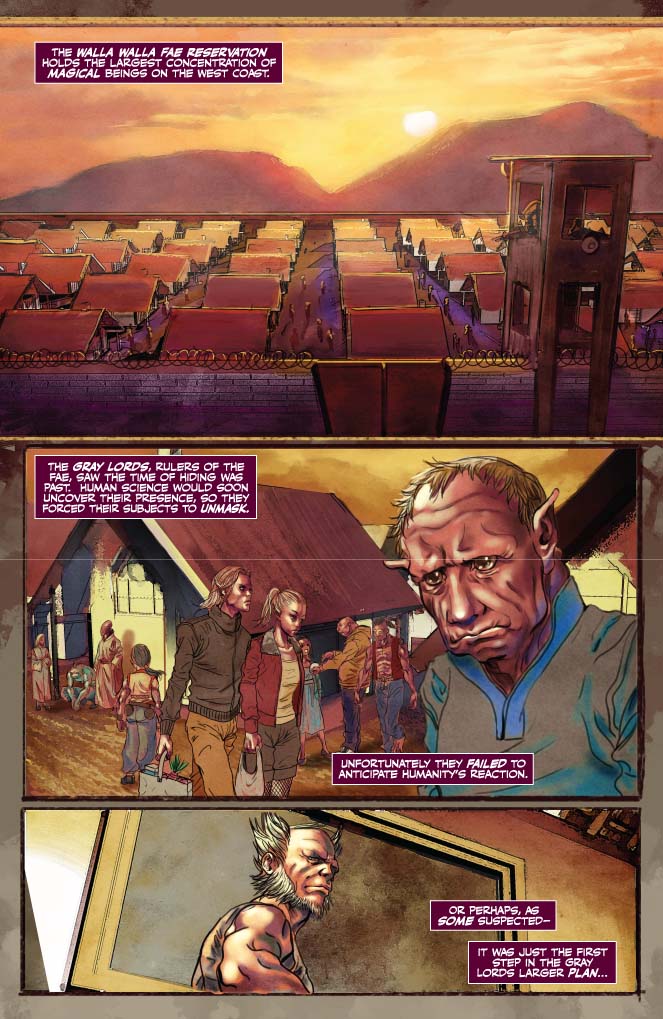
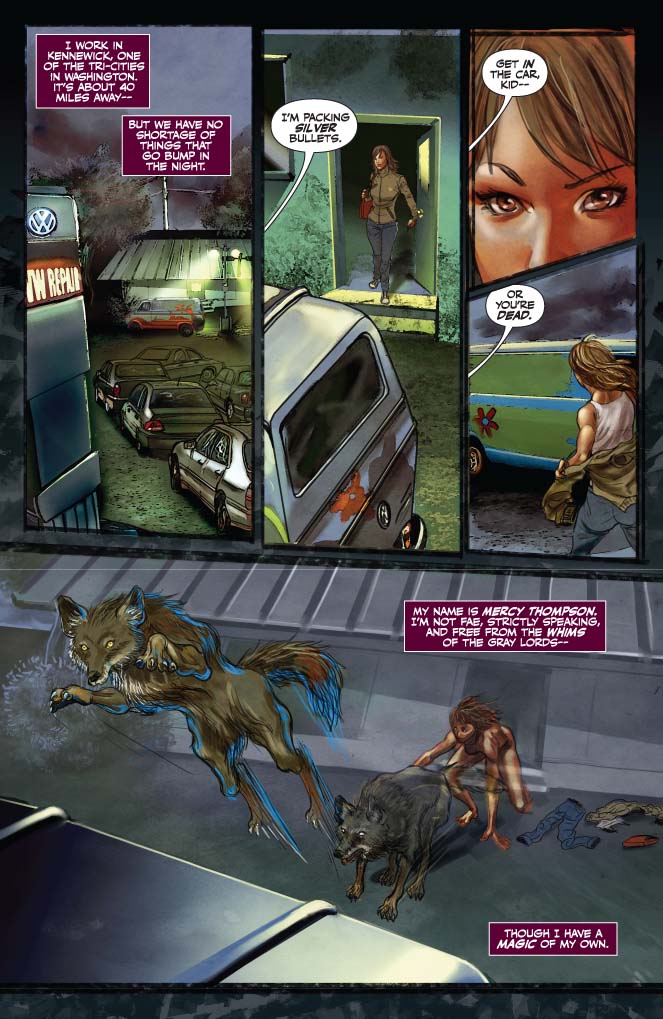
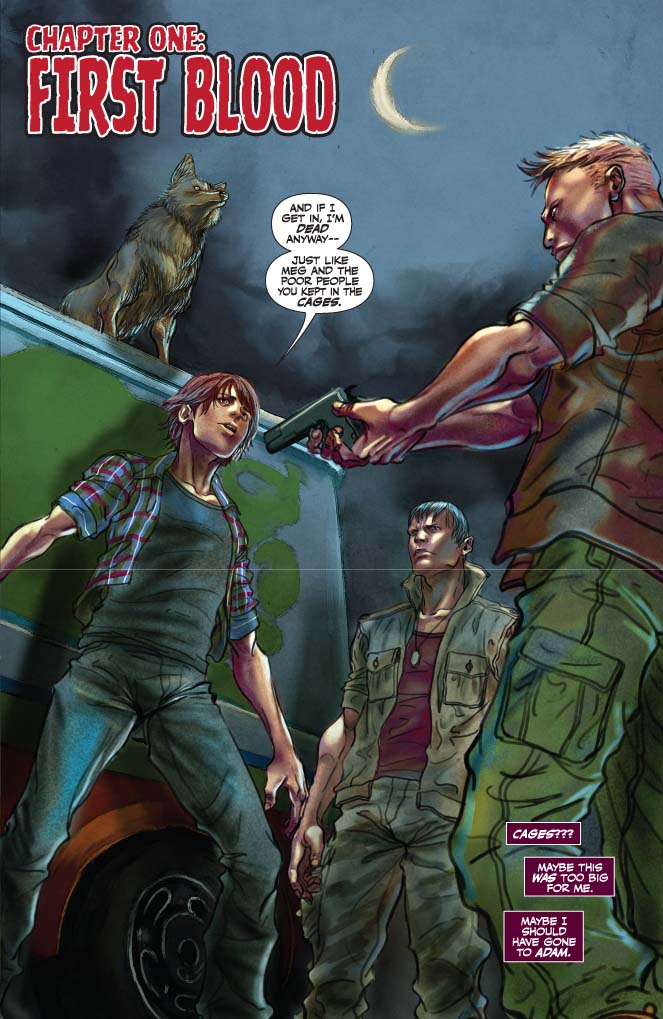
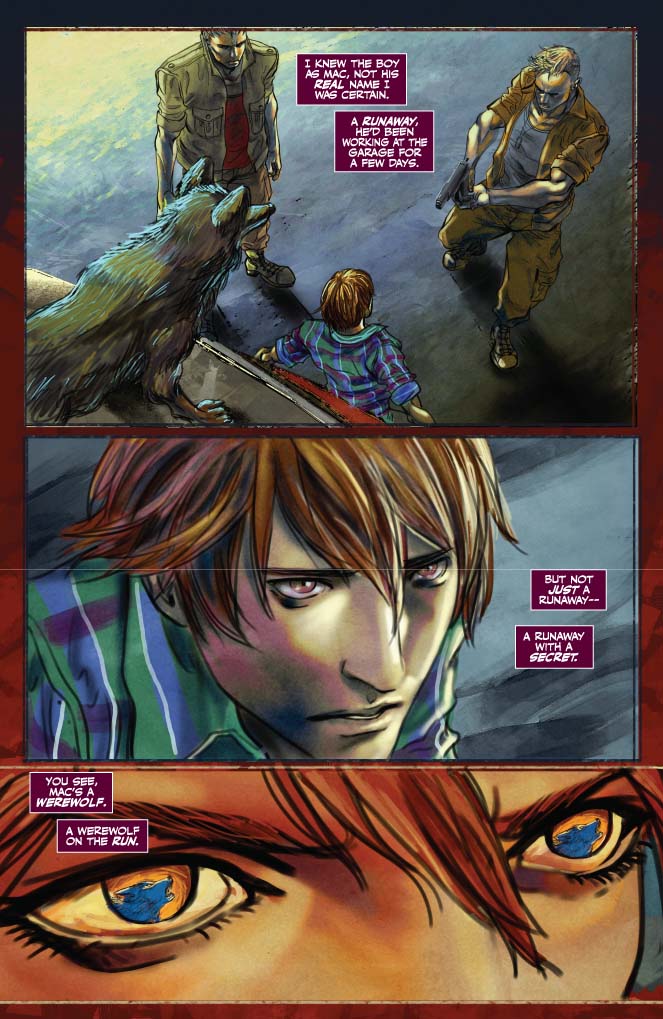
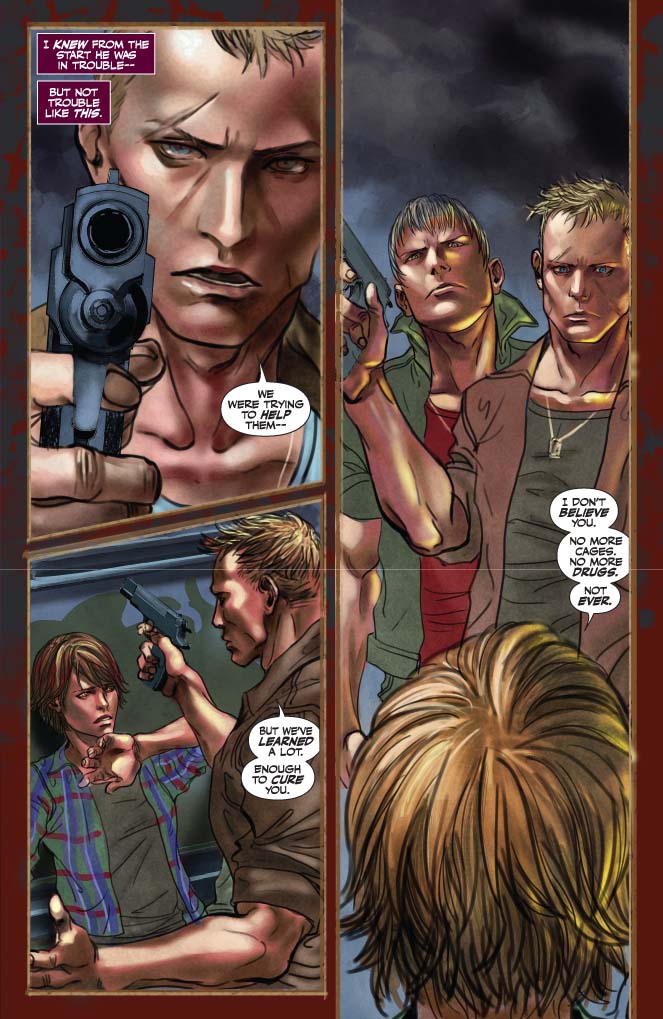



June 2011
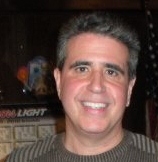
City: Pittsburgh...home of the six-time six-time six-time world champion Pittsburgh Steelers! Sorry, we Pittsburghers are like that. Though as I watch the union protesters in Madison Wisconsin I feel a lot better about that Super Bowl XLV loss to the Packers.
Comics: Currently Mercy Thompson: Moon Called & Alpha & Omega: Cry Wolf. Both are 8 issues adaptations of novels by urban fantasy author Patricia Briggs, a fine writer & an even better person. Also working on a graphic novel in Karen Moning’s Fever series for Del Rey.
Websites: N/A
QRD – How old were you when you first got into comics & did you always stick with them or did you come back to them? What was the first comic book you ever bought?
David – When I was growing up they were
everywhere. I was always aware of them so there was no single moment
of discovery. I began reading them regularly in about 1971, when
I was 10. I can only place it that exactly because it was right at
the time that Jack Kirby went to DC. I was home sick from school
for several days & one night my father bought me a stack of comics.
For whatever reason that was when I got hooked.
It was a pretty steady love affair for
about 15 years. I drifted away in the late eighties, I guess.
You can only read so many Batman or Spider-man stories before you kind
of feel like you’ve read them all.
These days my comic book reading is pretty
much limited to hardcover collections of Jack Kirby classics. I don’t
buy the Marvel stuff though, because they treated Jack pretty shabbily.
I got to meet his original partner Joe Simon at New York City Comic Con
last year. That was a real thrill. Got to meet the great Jerry
Robinson, creator of the Joker, too.
I was at a banquet once with Jack in attendance,
at San Diego Con in the late eighties. He didn’t seem to feel well
& his family seemed concerned so I let him be. God, what I wouldn’t
have given to meet him!
QRD – How old were you when you put out your first comic?
David – My brother Marc & I used to write & draw our own as kids. He was a pretty good artist. But nothing ever came of that. My first published work was in the black & white boom years. I guess it was 1986 so I was 25. That was Ex-Mutants. Of course, as things turned out that was nearly my last, too!
QRD – What decade do you think produced the best comics?
David – How do you pick? Every era
is different, with it’s own charms & own weaknesses. There’s
such a fun & vitality to stuff of the early Golden Age but a lot of
it is crap, too. Did you ever read the first issue of Captain Marvel
Adventures? Not the Whiz Comics premiere, but the first issue of
his own title. It is awful. & it was produced by Simon
& Kirby, for God’s sake, two of the all time greats. But it was
produced literally in a weekend, by Joe, Jack, & pretty much every
other professional they knew.
But you had Joe & Jack working, you
had Will Eisner, you had guys like Lou Fine & Reed Crandall & Jack
Cole & Mac Raboy. There was plenty of wonderful stuff around,
though you had to dig through a lot of dross to find it.
The fifties were the era of EC, really
a lot more sophisticated than most of what had come before & pretty
much anything that would come again for a long time. It’s sad really
what happened. Comics were still absolutely everywhere, not the niche
product they are today & were achieving a new maturity. Then
along came Dr. Wertham & whap! It’s kiddie time again.
By the time comics again creatively approached such a peak they had a much
smaller audience.
The sixties are defined by the emergence
of Marvel, the reemergence of Jack Kirby in partnership with Stan Lee,
& the notion the comic companies characters all inhabited the same
fictional universe. Despite the superior quality of the work there
were long term consequences, among them the virtual wipeout of genres other
than the superhero, that have negative reverberations to this day.
I suppose my favorite era is the seventies,
but of course it would be. That’s when I grew up. But Marvel
was still riding high on the creative wave the sixties had established.
DC was growing up & catching up. I really love the DC Comics
of that era. The Denny O’Neil & Neal Adams team on Batman &
Green Lantern. O’Neil & Curt Swan on Superman. Their run
is still my favorite Superman of all time.
In the eighties you have the emergence
of independent & creator owned comics. It was almost a repeat
of the Golden Age. Some incredibly creative, soaring stuff... &
reams & reams of crap you had to sort through to find it.
QRD – Why comics instead of just writing or drawing?
David – Though I can’t draw a lick I have a particular knack for telling a story with pictures. I think more in images when I write than I do in words. So I guess this medium is a natural fit for me.
QRD – Do you see mini-comics & indie comics as paths to mainstream comics or as their own unique media?
David – Um... both? I’m sure that a lot of people doing indie comics would love to do Spider-Man & just as many simply want to do their own thing & have no part of it.
QRD – How much do you think comics should cost?
David – A lot less than they do.
They have certainly outstripped inflation. In 1971 they cost 15 cents;
today they cost $4. That’s a 2500% increase! Even gasoline
hasn’t gone up that much!
I think the traditional 32 page pamphlet
is doomed. Long form stuff, graphic novel collections & such,
are going to outstrip them. I know that in my first collaboration
with Patty Briggs the collection sold more than twice as many copies as
all four issues of the original run combined.
QRD – How many books do you produce a year & how many would you like to?
David – Again, what I’m doing right now are mini-series. Eight issues has been the standard for the most part, done in a bit under a year. I’d like to write a couple titles a month all the time, but that is no sure thing.
QRD – Do you think stories should be serialized or delivered as complete works?
David – I think I said this before, but um...both? I try to create a complete story with a beginning, middle, & end each issue. The end is often a cliffhanger, but I still try to build to a crescendo. On the other hand, a couple of my very favorites among the stories I’ve done were stand alone 8 pagers. My god, what the greats like Kirby & Eisner & many, many others could accomplish in that many pages.
QRD – How are comic strips different than comic books & which medium do you prefer?
David – Sadly the adventure strip is virtually dead. It had to be an incredibly difficult medium to work in. Virtually the first third of every daily adventure strip was a recap. So when you read a collection there is a lot of repetition. But so many great creators came out of the strips. Alex Raymond, Hal Foster, Burne Hogarth, Elzie Segar, Chester Gould in the early years. There would have been no comic books without the comic strips & the great strips are generally accorded a higher degree of respect than their four-color cousins to this day.
QRD – How long is it from when you start a comic until it’s printed?
David – From start to finish for everyone
involved about 5 weeks. The scripting is quicker; usually about a
week but sometimes more & sometimes less. & when you are
doing adaptations you have to factor in taking the time to actually read
the book.
& I usually work fairly closely with
the artist, reviewing stuff & making suggestions as the pages come
in. I’ve also been working as the go between with the novelist &
the publisher on these titles because I’ve been working with Patty for
a couple of years.
QRD – What do you better with your comics now than when you first started?
David – I hope I’m a better writer than
I was 25 years ago. Would be a shame if I wasn’t. Moon Called
was actually the first adaptation I’ve had published & I’ve learned
a lot. What to leave in, what to leave out. I frequently find
I have to reorder events a bit. Comic book story telling is more
a straight line than a novel. Even with 8 issues space is considerably
more limited.
Weirdly, I started work on the other Briggs
novel, Cry Wolf, first & completed 3 issues of scripts. It was
a much more difficult book to adapt for a bunch of reasons. The artist
wasn’t working out so they went back to the drawing board, but I realized
those scripts had a lot of problems as well. So I had the chance
to go back & rewrite them, using what I’ve learned adapting the first
novel. Even though I’m covering the same ground the scripts are way,
way better the second time around.
QRD – At what point in the artistic process do you work digitally?
David – Everything is digital to a degree
these days. When I started I wrote on a typewriter, mailed the script
to the artist, who mailed it to the letterer, who mailed it to the inker,
who mailed it back & then if it was in color we shot stats that were
mailed to the colorist, who mailed them back, & finally we mailed the
whole thing to the printer.
Now I write on a computer, e-mail the
script to an artist, who may or may not draw with pencil & paper.
On Moon Called artist Amelia Woo does everything digitally, including colors.
Art is uploaded to an ftp & then the letterer does his job digitally.
It’s all put together in the end as a hi-res PDF which is then uploaded
to the printer’s FTP. Only after the book is actually printed is
there a physical object that ships somewhere.
On Cry Wolf artist Todd Herman draws with
old-fashioned paper & pencil but then he scans his pages & uploads
hi-res scans so the physical artwork again doesn’t go anywhere.
QRD – What do you think of digital comics & webcomics?
David – Nobody really knows what the future holds. I paid to attend a web comic seminar at a convention & it was the biggest waste of money ever. It was basically two hours long on talk & short on particulars. I think it makes little sense to do web comics without motion... but then you might as well include sound. At what point does it stop being a comic & become animation?
QRD – Do you prefer working in color or black & white?
David – Color, but that might be as much snobbery as creativity. A lot of black & white books just look like color books that nobody got around to filling in. There are different techniques, different ways of using tones, different approaches to your line. The difference is as stark as it is in black & white versus color filmmaking. At least it should be.
QRD – How many different people should work on a comic & what should their jobs be?
David – There is no answer. If you are Jack Kirby, three; Jack, an inker/letterer, & a colorist. If you’re not, a writer, an artist, possibly an inker, a letterer, a colorist, an editor. The number means nothing. It’s the result.
QRD – How do you find collaborators?
David – Depends. In the case of Amelia
Woo I recommended her when we lost another artist halfway through a project.
We had never worked together but we had the same agent & I was familiar
with her work. Todd Herman on Cry Wolf, I literally was just doing
some random googling to see who was out there that might fit. I suggested
we include him among the artists we gave try-outs. On the other hand,
I had no involvement at all in the selection of the artists who preceded
them.
QRD – How tight do you think a script
should be as far as telling the artist what to draw?
David – Relationships & collaborations
are all different. Jack Kirby & Steve Ditko did great stuff with
very little input from the writer until he filled in the dialogue.
Alan Moore wrote 200 page scripts for 22 page comics. I’m somewhere
in between.
I do work full script & consider it
akin to a screenplay or teleplay. Sometimes my descriptions are very
detailed, sometimes it’s not much more than “so & so talk” for 6 panels.
I usually break that down to get the rhythm of the conversation working.
I link to a lot of reference, sometimes
make detailed suggestions for layout, sometimes I just say “big panel.”
I have no issues with the artist making adjustments. Often they come
up with something that works far better than what I had imagined.
One thing I always like to do is sit down
with the completed art & the script & make a final pass before
it is lettered. Sometimes it’s small adjustments, a dialogue balloon
that works better if I move it from one panel to another. Sometimes
the art doesn’t quite match up with the dialogue. I also tighten
up the dialogue at that point. It sounds different in my head when
I’m looking at the pictures than it does without the art.
QRD – What comic book person would you be most flattered to be compared to?
David – Would you be even remotely surprised if I said Jack Kirby?
QRD – What do your friends & family think of your comics?
David – With most people it’s just kind of a vague “that’s cool.” Weirdly, it doesn’t help at all with the chicks.
QRD – What do you think of superheroes?
David – They have their place, but I like
a comic book universe with variety. I’ve really done very little
costumed hero work in my career. After Watchmen I kind of thought,
“What’s the point? Nobody is ever going to top this. Every
thing that can be said in the genre has been said.”
Other than Kirby I think the last comics
I read were the collected Freak Brothers by Gilbert Shelton. Another
freaking genius. Man, if you can get a hold of him that is somebody
you ought to talk to!
QRD – Marvel or DC?
David – I have more of a soft spot for the DC universe. But just the question limits your frame of reference. Why dismiss the Golden Age Captain Marvel? Why dismiss the Spirit? Why dismiss EC? Or even Warren, which did some really groundbreaking stuff in the early years.
QRD – What comic characters other than your own would you like to work with?
David – The Newsboy Legion with the Guardian. Seriously, that’s my first pick. Popeye. Star Trek. I’d love to do like one Batman story. Ben Grimm is my absolute favorite Marvel character.
QRD – Ideally would you self-publish?
David – Nah. I’m too cheap. Well, not cheap exactly. Ask any bartender who’s waited on me. Risk averse is more accurate.
QRD – What conventions do you try to attend & why?
David – Usually do Pittsburgh because I live here. New York Con. It’s relatively close & I love the town. Any excuse to go to NYC is all right by me. Done San Diego a few times. Might do it this year because Patty Briggs is doing the show & we’ve done a lot of work together without getting the chance to meet.
QRD – What do you do to promote your books?
David – Well, I do have a publisher doing most of that, but I’m always happy to take the time to talk to anyone about the books. I think it’s a real honor when people are interested enough in what you are doing to take the time to sit & talk about it.
QRD – Do you think your comics are well suited to comic shops or would sell better elsewhere?
David – I’d like the widest possible distribution through as many venues as possible. The major problem with the direct sales system is that distribution network is so limited. Kids aren’t just going to bump into comics at the drug store any more. We’re catering to the people who are already on board but not creating a new readership.
QRD – What other medium would you like to see some of your comics made into (television, film, games, action figures, etc.)?
David – Like any body else I would love to do a movie. I do have some projects that have made the rounds, but nothing has come of it yet.
QRD – Do you consider yourself a comic collector or a comic reader or both?
David – I’m a reader, period. It’s one of life’s greatest pleasures. I don’t understand the point of buying something & locking it up in plastic never to be seen.
QRD – What do you see as the most viable mediums for comics distribution 10 years from now?
David – I guess online. Brick &
mortar bookstores of all stripes are vanishing at an alarming rate.
They should probably be on the endangered species list.
It’s weird. I love going to a bookstore
& browsing. I can do it for hours. But most of the time
I just order on Amazon.
QRD – What would you like to see more people doing with comics?
David – Buying them! Reading them! Sharing them with their friends!
Other QRD interviews with
David Lawrence:
David
Lawrence interview (November 2004)






